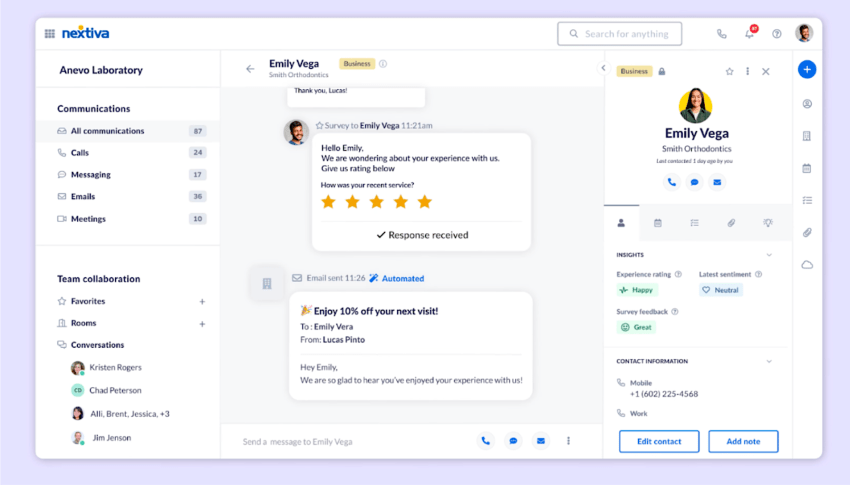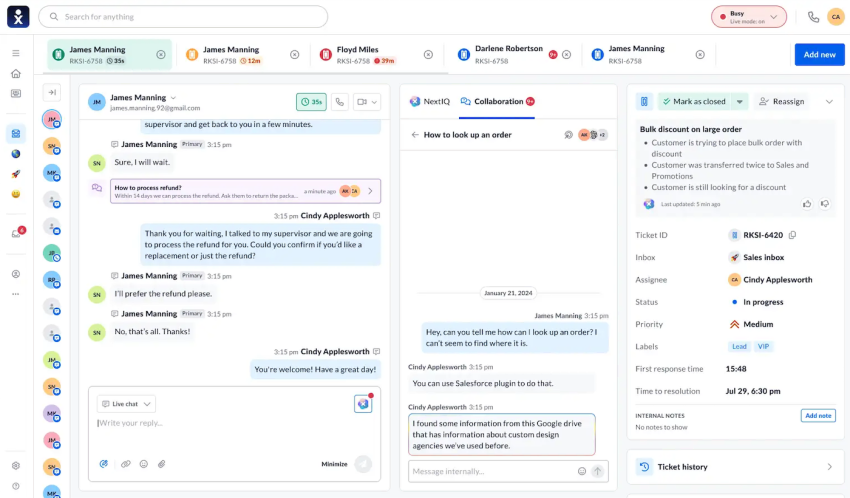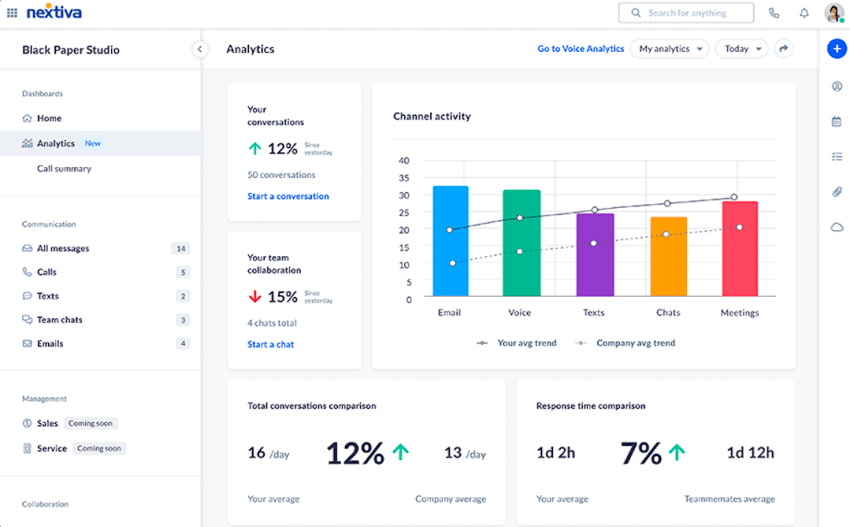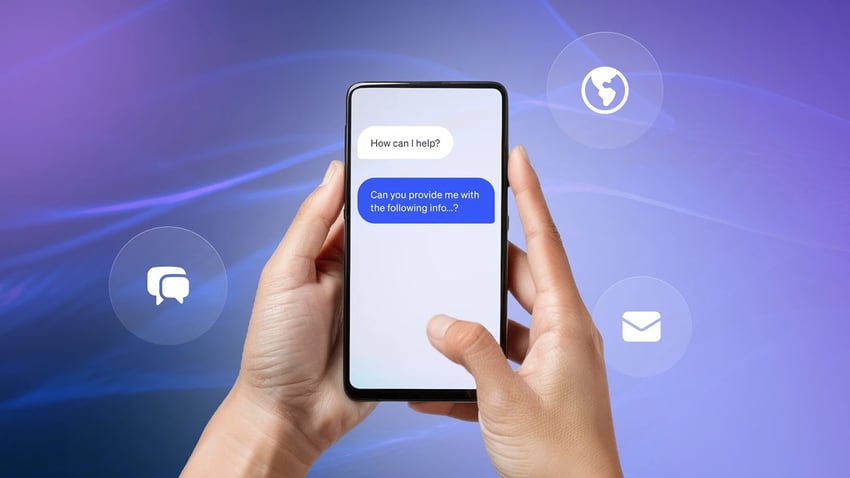Business-to-business (B2B) telemarketing is usually an acquired taste. Even if it’s your cup of tea, sharpening your skills is essential to keeping it enjoyable, especially in the B2B world.
B2B sales, whether inbound or outbound calls, take time. Building strong telemarketing sales skills can help you forge deeper connections with potential clients and successfully navigate those long sales cycles. At its core, telemarketing is about making a positive impact with every interaction.
Every interaction you have with a prospect is crucial. When you give them the right inputs, you can close deals faster. Ultimately, this gives you more time to gently push other deals forward, moving you up the call center leaderboard.
In this article, we’ll cover the top skills B2B marketing and sales professionals need to generate leads effectively using telemarketing strategies.
What Is B2B Telemarketing?
B2B telemarketing is the process of selling products and services to other companies using phone calls. Today’s telemarketers use other channels besides the phone to build close relationships with decision-makers at other companies, generate leads, increase brand awareness, and boost sales. This includes reaching out to potential customers via email, social media, and SMS, as well as using targeted prospecting and automated tools, and SaaS solutions to increase efficiency.
B2B vs. B2C Telemarketing: What’s the Difference?
While both use the phone, their strategies are worlds apart. B2C (Business-to-Consumer) telemarketing aims for a quick, emotional sale to an individual. B2B telemarketing is a more strategic, long-term process focused on logic and value.
| Factor | B2B telemarketing | B2C telemarketing |
|---|---|---|
| Goal | Set a qualified appointment or demo | Make an immediate sale |
| Sales cycle | Long (weeks or months) | Short (often one call) |
| Value prop | Focus on ROI, efficiency, and solving business problems | Focus on personal benefits, price, and desire |
| Audience | Specific roles in a company (e.g., VP of Sales) | Broad individual consumers |
Why B2B Telemarketing Still Matters (The Benefits)
Many people assume phone calls are outdated, yet sales teams continue to pick up the phone because telemarketing works, and nothing qualifies a lead faster than a real conversation. When you talk to someone, you hear everything that a form or click can’t show, like the tone, the hesitation, the curiosity. You can tell who’s serious and who’s just browsing.
Using B2B telemarketing as part of your marketing strategy keeps your outreach targeted and successful. A strong call delivers what digital tools often miss:
- Generate high-quality, qualified leads: A direct conversation quickly uncovers a prospect’s needs, budget, and decision-making authority. It helps your in-house sales team to separate high-intent buyers from casual researchers in minutes, which enhances lead generation and telemarketing services.
- Get instant, unfiltered market feedback: Live calls give you real-time reactions to your message, pricing, and product features. You immediately learn what resonates and what doesn’t with your target market.
Build customer relationships and trust: B2B sales cycles run long, and trust drives progress. A genuine, professional phone call builds rapport that no automated email or direct mail can match. This direct input also helps you fine-tune your pitch. - Reach decision-makers directly: While inboxes overflow, a well-planned call allows you to connect with the person who can make the final decision, thereby improving customer support and accelerating your sales process.
Types of B2B Telemarketing Campaigns
B2B telemarketing covers several focused campaign types, each with a distinct business goal.
- Lead generation: Sales teams actively call cold or warm leads from a targeted list to identify potential customers, assess their interest, and create new sales opportunities.
- Appointment setting: Telemarketers contact prospects to schedule qualified meetings or product demos, ensuring senior sales representatives meet only pre-qualified leads.
- Lead nurturing and follow-up: Representatives engage prospects who have already shown interest, such as downloading a resource or attending a webinar, to answer questions, provide insights, and move them closer to a purchase decision.
- Market research and surveys: Telemarketing teams collect valuable customer feedback, test new product concepts, and analyze how target audiences perceive current solutions to inform business strategies.
- Event promotion: Reps reach out to relevant contacts to promote webinars, conferences, or trade shows, secure registrations, and encourage active participation.
- Direct sales: For simpler or lower-cost B2B offerings, telemarketers sell products or services directly over the phone, completing transactions successfully.
- Database cleansing and enrichment: Teams regularly verify and update CRM records by confirming phone numbers, contact details, job roles, and company changes, keeping data accurate and actionable.
Top 6 Challenges With B2B Telemarketing (+Solutions)
Below are some challenges of B2B telemarketing you might face in your day-to-day role.
1. Shift from cold calls to multichannel engagement
Using multiple channels may not seem attractive when you have extensive cold-calling experience. Although it may involve playing far from your strength, today’s buyers want this option. They prefer async communication via email, chat, messaging, or social media. Some buyers expect a phone call will put them under pressure to buy. They prefer more space when making informed decisions.
According to a survey, business owners prefer to be contacted via email or phone, and some wish not to be contacted at all. To succeed, you must make it easy for prospects to find you through multichannel engagement strategies.
Async channels give potential customers the space they need. Pairing calls with email and social touchpoints helps reduce that feeling of pressure, as buyers get the time they need to respond or make a decision.

2. Navigating complex buying committees
A company’s purchasing decisions depend on various factors, including the size of the deal, the added value, the departments involved, and the impact on compliance. These factors have become more complex with time.
When making purchases, 46% of business owners are greatly influenced by other owners who are using the product or service. This means developing strong relationships with your prospects goes beyond closing the deal. These people become reliable references when other potential customers are considering purchasing.
A company’s employees also influence decision-making. Stakeholders rely on the vendor to educate them about the product or service, but other business owners and employees influence the buying decision. This increases the number of actual stakeholders in a business deal.
In working to close deals as a B2B telemarketer, it pays to develop good relationships with those who influence decisions, as well as the company’s buyer.
3. Using AI without losing the human touch
AI strengthens B2B telemarketing strategies and telemarketing software by automating repetitive tasks and delivering real-time insights without replacing the human connection that drives conversations. It acts as a co-pilot for agents and provides support rather than working as a substitute or replacing them. Here are a few modern features that illustrate this:
- With AI-powered call summaries, the system automatically records key discussion points and next steps after each call, cutting down manual note-taking so agents can focus on building relationships and the next conversation.
- With real-time agent coaching, AI listens for triggers such as competitor mentions or pricing questions and instantly displays tailored scripts, talking points, or objection-handling guidance on the agent’s screen to help them respond confidently.
- With sentiment analysis, supervisors have a clear view of customer tone and agent performance trends, enabling them to intervene proactively when deals or relationships need extra attention.

4. Meeting high expectations for personalization
Personalization is critical in cold calls and warm calls. These days, random cold calls don’t make a positive impression of your brand. When you call buyers, they expect you to tailor the outreach based on their business.
This means you’re expected to research prospects before reaching out. If you’re contacting them for the first time, it helps to familiarize yourself with their background, getting a rough picture of their role and the challenges they face that would encourage them to consider your solution.
If you’re reaching out as a follow-up, refer to your phone system or CRM to get a clear picture of the previous conversations. This allows you to customize your calls with the context needed to deliver a pleasing customer experience.
4. Overcoming prospect fatigue and call avoidance
The number of cold calls a decision-maker receives daily depends on their role, the size of the team, and the industry. In most cases, there are many. With this daily flood of calls and emails, many buyers are reluctant to get on a call.
To engage this fatigued prospect, you’ll need some creative sales strategies to ensure you provide value in every interaction. This will allow you to differentiate yourself from others, which becomes easier when you start engaging prospects on multiple channels.
5. Managing high agent turnover and burnout
Skilled B2B telemarketers are valuable, but burnout is high. This is often a technical problem, not just a human one. When agents have to fight their tools — like a clunky CRM, a separate dialer, and no easy way to see past interactions — it leads to frustration, exhaustion, and high turnover.
Retaining top talent means providing them with a seamless, unified tech stack that works for them, not against them.
6. Staying compliant with TCPA & GDPR
The legal framework poses a significant challenge for B2B telemarketing teams. Strict regulations such as the Telephone Consumer Protection Act (TCPA) in the US and the General Data Protection Regulation (GDPR) in Europe impose hefty fines for non-compliance.
Adhering to these rules, which govern call times, consent, and the right to be removed from a list, is a constant operational hurdle. Failure to adhere to these best practices not only risks financial penalties but can also permanently damage your brand’s reputation with potential customers.

11 B2B Telemarketing Best Practices for Agents
Success in B2B telemarketing comes from a blend of solid preparation, smart strategy, and the right technology. Here are 10 essential best practices to build your skills and improve your call outcomes.
1. Stop cold calling and do your homework first
Truly, “cold” calls are inefficient. Before you dial, conduct thorough research on the company and the prospect. Use tools like LinkedIn Sales Navigator to understand their role, recent company news, and industry challenges.
This preparation also involves lead qualification. Use your lead-scoring models to prioritize high-value prospects that match your ideal customer profile (ICP). This ensures you’re spending your valuable time on high-quality leads that have a genuine potential to convert, turning a cold call into a warm, relevant conversation.

2. Use scripts as a guide, not a cage
A sales script should inspire, not force, a conversation. Communication must be natural. If you sound like a robot, buyers will avoid sharing real information.
Your script should be a flexible framework, not a word-for-word mandate. It should provide:
- Different opening value propositions.
- Key pain points to listen for.
- A clear call-to-action (like booking a demo).
- Standard next steps.
This allows you to be prepared while still having the freedom to adapt to the prospect’s personality and needs.

3. Create a multi-touchpoint strategy
Don’t rely on phone calls alone. B2B deals take time and persistence. A successful strategy involves a mix of channels. When a prospect misses your call, drop them a concise voicemail.
Follow up with a thoughtful email 24-48 hours later. If they’re active on LinkedIn, combine email marketing with calls and LinkedIn engagement to support your sales funnel. The key is to follow up religiously, acting as a helpful resource, not a pushy salesperson.
A good sequence might be: Call 1 (Voicemail) -> Email 1 -> LinkedIn Connect -> Call 2 -> Email 2.
4. Treat the “gatekeeper” as an ally
The executive assistant or receptionist isn’t an obstacle; they’re a vital part of the process. Treat them with respect, not as a barrier to get past. Be professional, clear, and state your purpose.
Instead of trying to “trick” them, try being transparent:
“Hi, I was hoping to speak with [Prospect’s Name].
My name is [Your Name] from [Your Company], and I’m calling to share some information on how we’ve helped other VPs of Operations in the manufacturing space reduce their shipping costs. Would you be the right person to speak with about that, or would you be able to point me in the right direction?”

“View each call you make, email you send, or whatever communication you’re using as an opportunity to positively impact the person you’re trying to reach.”
— Mark Hunter
5. Practice role-playing objections
You will face objections — it’s a guaranteed part of the job. Proactively analyze your calls to find the most common ones, like “We already have a vendor” or “Just send me an email.”
Use role-playing with your team to simulate these situations. This helps you practice:
- Reframing: Turn an objection like “We don’t have the budget” into a new conversation: “I understand. Many of our clients said the same before they saw how our system could reduce their IT spend by 30%. Could I share a 2-minute case study with you?”
- Accepting: Sometimes, the best response is to gracefully accept the “no.” When a buyer says they’re not interested, responding with, “I appreciate your honesty. I’ll make a note not to call you about this again,” can make them less defensive and surprisingly more open to a final question.
6. Ask open-ended questions
The most successful telemarketers listen more than they talk. To do this, you must avoid “yes” or “no” questions. Use open-ended questions that start with “what,” “how,” or “why” to encourage the prospect to share their challenges.
- Instead of: “Are you happy with your current phone system?”
- Try: “What’s been the most frustrating part of managing your current phone system?”
- Instead of: “Do you need call reporting?”
- Try: “How does your team currently track call performance and agent productivity?”
This shifts the call from a pitch into a consultation.
7. Practice active listening (and paraphrasing)
The goal of a call is not to just get through your pitch; it’s to uncover information. Practice active listening —that means listening to understand, not just to wait for your turn to talk. Don’t be afraid of a little silence.
When a prospect finishes a thought, paraphrase it back to them (“So, if I’m hearing you right, your current system isn’t giving your managers the data they need?”). This confirms you’re listening and builds trust.

“Empathy requires paying attention to others’ words and body language, noticing the feelings that arise within us when we interact with them, and asking them about their feelings. Doing this regularly refines our capacity to sense other people’s emotional experience accurately.”
— Dr. Ronald Siegal, PsyD
8. Know the best days and times to call
Calling a prospect at 9:01 AM on a Monday is rarely effective. While every industry is different, data consistently shows that the best times to reach B2B prospects are mid-week (Wednesday and Thursday) during two key windows:
- Mid-Morning: 10:00 AM – 11:30 AM
- Late-Afternoon: 3:00 PM – 5:00 PM
Avoid Monday mornings (when people are planning their week) and Friday afternoons (when people are wrapping up). Test these windows and track your own “connect rate” to find the sweet spot for your specific audience.
9. Lead with value, not your pitch
Your prospect doesn’t have time for a long-winded pitch about your company’s history. Experts suggest 80% of cold calls fail in the first 30-90 seconds. You must lead with value.
Focus on solving a prospect’s specific pain point, not giving a broad product overview. Make your pitch short and value-driven.
- Bad pitch: “We’re a leading provider of cloud communications with a 99.999% uptime and…”
- Good pitch: “I’m calling because I saw you’re hiring 20 new remote employees. I have a 2-minute idea on how our clients are onboarding remote teams in under a day without shipping them any hardware.”

10. Have a clear call-to-action (CTA)
Never end a call vaguely. Every single interaction must have a clear, specific “next step.” Your CTA isn’t always “buy now.” It’s usually a small, low-friction task that moves the prospect to the next stage.
- “Would you be open to a 15-minute demo next Tuesday?”
- “Can I send you a one-page case study on how [Competitor] solved this?”
- “If I follow up via email, are you the right person to speak with, or is there someone else I should include?”
11. Focus on your tone and delivery
In telemarketing, how you say something is more important than what you say. Your tone should be confident, calm, and professional. Speak clearly and at a measured pace — don’t rush your words.
The most important (and simple) technique is to smile before you dial. A smile is audible in your voice and makes you sound more approachable and friendly from the very first second.
What Technology Do You Need In Your B2B Telemarketing Tech Stack
Even the best agents can’t succeed with outdated tools. A B2B tech stack runs a high-performing telemarketing team, automating busy work and providing critical insights. Here are the essential components:
1. A cloud call center software
This is the non-negotiable foundation. Traditional landlines are obsolete. A cloud call center software that uses Voice over Internet Protocol (VoIP) runs your calls over the internet, giving your team the flexibility to make and receive calls from their computer, mobile app, or desk phone.
Key features to look for in a cloud phone system:
- A mobile & desktop app: Let your team work from anywhere.
- Call recording: Essential for training, quality assurance, and compliance.
- Call analytics: Provides basic data on call volume, duration, and answer rates.

2. Customer relationship management (CRM) system
Your CRM is your team’s “single source of truth.” It’s where all prospect data, interaction history, and deal statuses are stored. A telemarketer working without a CRM is working blind.
Key features to look for:
- Interaction history: A single view of every email, chat, and call.
- Lead scoring: Automatically prioritizes your hottest leads.
- Task management: Reminds agents when to make their next follow-up call.

3. A dialer (auto-dialer or power-dialer)
Automated outbound dialers automate the manual process of punching in numbers. This one tool can boost agent productivity by 2-3x.
- Power dialer: Automatically dials the next number on a list as soon as an agent finishes their previous call.
- Predictive dialer: Dials multiple numbers at once and only connects the agent when a live human picks up. This is best for high-volume call centers.

4. UCaaS + CCaaS integration
The biggest challenge isn’t having these tools; it’s that they don’t talk to each other. Agents waste time switching between their phone, their CRM, and their dialer (“swivel-chair” work).
This is where a unified platform comes in. A Unified Communications (UCaaS) and Contact Center (CCaaS) solution, like Nextiva, combines all these tools into one application.
When a call comes in, the agent’s screen instantly shows the caller’s entire CRM history before they even say hello. When they finish a call, the recording and notes are logged to that contact’s record automatically. This seamless integration is the single biggest driver of telemarketing efficiency and personalization.

How To Measure B2B Telemarketing Success (Key KPIs)
Tracking your telemarketing efforts allows teams to identify what works, improve weak areas, and scale successful strategies. While each campaign has unique objectives, the right metrics reveal meaningful progress besides call volume or activity levels.
Track these metrics to ensure telemarketing works and remains cost-effective:
- Call connect rate: This metric measures how many calls reach a live person. A low connect rate can indicate poor list quality or suboptimal calling times, while a high rate shows your outreach strategy is impactful and your targeting is on point.
- Lead conversion rate (LCR): LCR tracks how many calls result in a qualified lead or confirmed meeting. This metric shows how well agents and scripts convert conversations into genuine business opportunities.
- Average call duration: Average call duration indicates the depth of engagement. Short calls may signal weak targeting or ineffective scripts, while longer conversations suggest strong rapport and real prospect interest.
- Follow-up rate: This metric measures how consistently your team reconnects with leads after the initial call. High follow-up rates demonstrate disciplined execution and a well-managed and healthy pipeline process.
- Cost per lead (CPL): CPL calculates the time and budget spent to generate one qualified lead. This metric highlights the actual return on investment (ROI) from your telemarketing investments and efforts.
Voice analytics tools can automatically track these KPIs, providing teams with actionable insights to monitor performance patterns, coach agents constructively, and refine campaigns based on real data.

Scale Your Telemarketing Efforts With the Right Phone System
B2B outbound telemarketing is a rewarding area to explore and master. Modify your strategies based on insights from this article and use the best practices to improve your skills.
On this journey toward increased efficiency and impact, you can rely on Nextiva’s business phone system to match your pace. It offers the analytics you need to improve, presents your progress on a user-friendly interface, and takes your business further with the help of actionable suggestions generated by the system.

Book a demo with Nextiva and make the most of your skills in B2B telemarketing.
Build Amazing Customer Experiences
Transform customer experience on a Unified Customer Experience Management platform designed to help you acquire, retain, and grow your customers.
B2B Telemarketing FAQs
While it’s to generate revenue, the primary goal of a B2B telemarketing call is rarely to make a sale on the spot. Instead, the goals are to qualify a lead, build a relationship, and secure the next step, which is usually a longer demo or a meeting with a sales executive.
Yes, but only when done correctly. Old-school “smile and dial” cold calling is no longer effective. Modern, successful B2B telemarketing is a multi-touchpoint strategy that is highly personalized, research-driven, and respects the buyer’s time. It’s one part of a larger engagement strategy.
Outbound telemarketing is when a sales agent initiates the call to a prospect who may not be aware of their solution (a “cold” or “warm” call).
Inbound telemarketing is when an agent answers a call from a prospect who is responding to a marketing campaign, such as a “request a demo” button on the website.
B2B cold calling is legal, but businesses must comply with data privacy laws. In most regions, including the U.S., EU, and UK, companies can call other businesses based on legitimate interest as long as they clearly identify themselves, use verified contact lists, and promptly honor any opt-out requests.

















 Marketing & Sales
Marketing & Sales 











